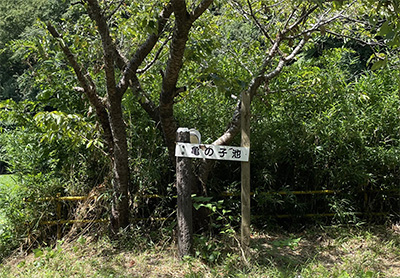

さてしばらくブログでは東国三社シリーズ、スピンアウトで龍角寺と古建築探訪。
本日はちょっとテーマ休止で「水入り」であります。写真は龍角寺を離れた途端に目に飛び込んできた名前もよくわからなかった景観。よく見てみたら「亀の子池」という名札を発見できました。
関東の利根川が東遷されていってその太平洋への注ぎ口の周辺、歴史年代では「香取の海」というような、瀬戸内海とも対比されるような内海地域が広がっていたとされるのですね。
そういう古代の歴史年代の風景の残滓が、こういった水郷の風景には残されている。
地球史の時代区分として最近は「人新世」、ようするに地球環境全体の変容に人類の活動が大きな要因としてカウントされるようになってきている。そのなかでも日本というの列島社会は、それがたぶん景観として目に見えて認識可能なのではないかと思います。
気候的には米作適地であり、そういうなかで多様な暴れ川などが洪水を繰り返す環境。一方で写真のような起伏景観形状が水郷的地帯にはたくさん広がっていた。
縄文海進のころにはこういう地形の場所に海が広がり、それこそ「海の幸・山の幸」によって縄文人の牧歌的な暮らし方を支えていたのでしょう。
そのあと海進が徐々に後退して陸地化が進み、活発に人間たちによる「自然改造」が展開されていって、広大な農耕適地が姿を現していったのでしょう。
江戸初期という特定された時期に利根川東遷という大自然改造が果たされて、まさに「人新世」的に国土改造がされて人間に暮らしやすいように自然改変されたのだ。まさに人新世の縮図かも知れない。
人為的自然改造の結果、江戸・東京という人類規模でも相当巨大な都市地域が誕生していったことも、きわめて特徴的なこととして抑えておくべきなのでしょう。
いったん改造されていけば過去は忘却されていくけれど、歴史を丹念にたどれば、そういう実相も浮かび上がってくる。そういう大きな人間活動の底流を抑えていくと、歴史事実の背景理解にも自然に波及していく切り口になるのでしょう。歴史はいろいろなことを教えてくれますね。
海辺の人間環境として房総半島南端の勝浦は、比較的に涼しい夏を楽しめるという。縄文の人びとの方が、酷暑に打ちのめされる現代人よりも快適な生き方だったのかもしれないと、この亀の子池の風景を見ていてこころに染みておりました。
ことしの猛暑、さてどこまで続くのか、北海道では少しはクールダウンしていると思いますが、本州以南各地のみなさん、ご自愛ください。
English version⬇
Seasonal “Mizuiri” – idyllic water town scenery
Remnants of the Jomon sea advance. The landscape of the water village reminds us of the “Sea of Katori”, which is similar to the Seto Inland Sea. The Japanese archipelago of Kanto may be a symbolic zone of the “Anthropocene. Japan and Kanto may be a symbolic zone of the “new human age.
For a while now, I have been blogging about the three shrines in the eastern part of Japan and spinning out to visit Ryukakuji Temple and other ancient architectural sites.
Today, we will pause for a moment on the theme of “Mizuiri” (entering the water). The photo is of a landscape that caught my eye as soon as I left Ryukaku-ji Temple, and whose name I could not quite make out. I took a closer look and found a nameplate that read “Kame-no-ko ike” (turtle pond).
The Tone River in Kanto was shifted to the east, and around its outlet to the Pacific Ocean, there was an inland sea area called “Katori no Umi” in historical times, which is said to be in contrast with the Inland Sea of Seto Inland Sea.
The landscape of these water villages retains remnants of the landscape of the ancient historical period.
Recently, human activities have come to be counted as a major factor in the “Anthropocene,” or the transformation of the global environment as a whole. Among these, Japan, as an archipelagic society, can probably be visibly recognized as a landscape.
Climatically, it is a suitable place for rice cultivation, and in such an environment, various rivers repeatedly flood the land. On the other hand, there were many undulating landscapes like the one in the photo in the suigo-like area.
At the time of the Jomon sea advance, the sea spread across these landforms, and the “delicacies of the sea and mountains” must have supported the pastoral way of life of the Jomon people.
Later, as the advance of the sea gradually receded and the land became more and more terrestrial, humans began to actively “transform nature” and vast areas suitable for farming emerged.
In the early Edo period (early 20th century), the Tone River was moved eastward, a major natural transformation was accomplished, and the land was modified in the manner of the “Anthropocene” to make it easier for people to live in the country. This may be the epitome of the Anthropocene.
The fact that Edo/Tokyo, an urban area of considerable size even on a human scale, was born as a result of the artificial natural transformation should also be kept in mind as a very characteristic fact.
Once a city is remodeled, the past is forgotten, but if history is carefully traced, such a reality will emerge. If we can suppress the underlying currents of human activity, it will naturally lead to a better understanding of the background of historical facts. History teaches us many things.
As a seaside human environment, Katsuura at the southern tip of the Boso Peninsula is said to enjoy comparatively cool summers. Looking at the scenery of Kame-no-ko Pond, I was deeply impressed by the fact that the Jomon people may have had a more comfortable way of life than modern people who are beaten down by the extreme heat.
I wonder how long the heat wave will last this year. I think it has cooled down a bit in Hokkaido, but I hope everyone south of Honshu will take care of themselves.
Posted on 8月 19th, 2023 by 三木 奎吾
Filed under: 日本社会・文化研究







コメントを投稿
「※誹謗中傷や、悪意のある書き込み、営利目的などのコメントを防ぐために、投稿された全てのコメントは一時的に保留されますのでご了承ください。」
You must be logged in to post a comment.